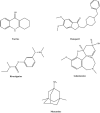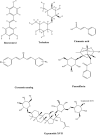Therapeutic Potential of Vital Transcription Factors in Alzheimer's and Parkinson's Disease With Particular Emphasis on Transcription Factor EB Mediated Autophagy
- PMID: 34970114
- PMCID: PMC8712758
- DOI: 10.3389/fnins.2021.777347
Therapeutic Potential of Vital Transcription Factors in Alzheimer's and Parkinson's Disease With Particular Emphasis on Transcription Factor EB Mediated Autophagy
Abstract
Autophagy is an important cellular self-digestion and recycling pathway that helps in maintaining cellular homeostasis. Dysregulation at various steps of the autophagic and endolysosomal pathway has been reported in several neurodegenerative disorders such as Alzheimer's disease (AD), Parkinson's disease (PD), and Huntington disease (HD) and is cited as a critically important feature for central nervous system (CNS) proteostasis. Recently, another molecular target, namely transcription factor EB (TFEB) has been explored globally to treat neurodegenerative disorders. This TFEB, is a key regulator of autophagy and lysosomal biogenesis pathway. Multiple research studies suggested therapeutic potential by targeting TFEB to treat human diseases involving autophagy-lysosomal dysfunction, especially neurodegenerative disorders. A common observation involving all neurodegenerative disorders is their poor efficacy in clearing and recycle toxic aggregated proteins and damaged cellular organelles due to impairment in the autophagy pathway. This dysfunction in autophagy characterized by the accumulation of toxic protein aggregates leads to a progressive loss in structural integrity/functionality of neurons and may even result in neuronal death. In recent years TFEB, a key regulator of autophagy and lysosomal biogenesis, has received considerable attention. It has emerged as a potential therapeutic target in numerous neurodegenerative disorders like AD and PD. In various neurobiology studies involving animal models, TFEB has been found to ameliorate neurotoxicity and rescue neurodegeneration. Since TFEB is a master transcriptional regulator of autophagy and lysosomal biogenesis pathway and plays a crucial role in defining autophagy activation. Studies have been done to understand the mechanisms for TFEB dysfunction, which may yield insights into how TFEB might be targeted and used for the therapeutic strategy to develop a treatment process with extensive application to neurodegenerative disorders. In this review, we explore the role of different transcription factor-based targeted therapy by some natural compounds for AD and PD with special emphasis on TFEB.
Keywords: Alzheimer’s disease; NF-κB; Parkinson’s disease; TFEB; autophagy.
Copyright © 2021 Rai, Tiwari, Singh, Mishra, Singh, Hooshmandi, Vamanu and Singh.
Conflict of interest statement
The authors declare that the research was conducted in the absence of any commercial or financial relationships that could be construed as a potential conflict of interest.
Figures




Similar articles
-
TFEB dysregulation as a driver of autophagy dysfunction in neurodegenerative disease: Molecular mechanisms, cellular processes, and emerging therapeutic opportunities.Neurobiol Dis. 2019 Feb;122:83-93. doi: 10.1016/j.nbd.2018.05.012. Epub 2018 May 28. Neurobiol Dis. 2019. PMID: 29852219 Free PMC article. Review.
-
TFEB in Alzheimer's disease: From molecular mechanisms to therapeutic implications.Neurobiol Dis. 2022 Oct 15;173:105855. doi: 10.1016/j.nbd.2022.105855. Epub 2022 Aug 27. Neurobiol Dis. 2022. PMID: 36031168 Review.
-
Novel Insight into Functions of Transcription Factor EB (TFEB) in Alzheimer's Disease and Parkinson's Disease.Aging Dis. 2023 Jun 1;14(3):652-669. doi: 10.14336/AD.2022.0927. Aging Dis. 2023. PMID: 37191408 Free PMC article. Review.
-
The regulatory mechanism and therapeutic potential of transcription factor EB in neurodegenerative diseases.CNS Neurosci Ther. 2023 Jan;29(1):37-59. doi: 10.1111/cns.13985. Epub 2022 Oct 2. CNS Neurosci Ther. 2023. PMID: 36184826 Free PMC article. Review.
-
The Autophagy-Lysosomal Pathway in Neurodegeneration: A TFEB Perspective.Trends Neurosci. 2016 Apr;39(4):221-234. doi: 10.1016/j.tins.2016.02.002. Epub 2016 Mar 9. Trends Neurosci. 2016. PMID: 26968346 Free PMC article. Review.
Cited by
-
Cognitive- and memory-enhancing effects of Augmentin in Alzheimer's rats through regulation of gene expression and neuronal cell apoptosis.Front Pharmacol. 2023 Mar 9;14:1154607. doi: 10.3389/fphar.2023.1154607. eCollection 2023. Front Pharmacol. 2023. PMID: 36969860 Free PMC article.
-
Oxytosis/Ferroptosis in Neurodegeneration: the Underlying Role of Master Regulator Glutathione Peroxidase 4 (GPX4).Mol Neurobiol. 2024 Mar;61(3):1507-1526. doi: 10.1007/s12035-023-03646-8. Epub 2023 Sep 19. Mol Neurobiol. 2024. PMID: 37725216 Review.
-
Tangeretin confers neuroprotection, cognitive and memory enhancement in global cerebral ischemia in rats.3 Biotech. 2024 Jan;14(1):9. doi: 10.1007/s13205-023-03854-y. Epub 2023 Dec 8. 3 Biotech. 2024. PMID: 38074289 Free PMC article.
-
An Update of Fungal Endophyte Diversity and Strategies for Augmenting Therapeutic Potential of their Potent Metabolites: Recent Advancement.Appl Biochem Biotechnol. 2025 May;197(5):2799-2866. doi: 10.1007/s12010-024-05098-9. Epub 2025 Feb 5. Appl Biochem Biotechnol. 2025. PMID: 39907846 Free PMC article. Review.
-
An update on pathogenesis and clinical scenario for Parkinson's disease: diagnosis and treatment.3 Biotech. 2023 May;13(5):142. doi: 10.1007/s13205-023-03553-8. Epub 2023 Apr 27. 3 Biotech. 2023. PMID: 37124989 Free PMC article. Review.
References
Publication types
LinkOut - more resources
Full Text Sources

